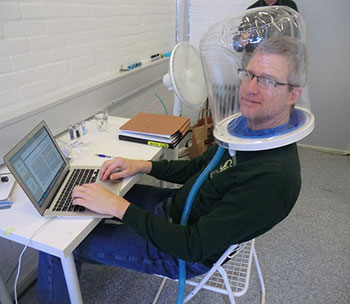Some air pollutants seep through skin
For some chemicals, uptake through skin can at least match entry via the lungs

Some chemicals can seep into a person’s body as readily through the skin as via breathing, new studies show. These chemicals are found in products ranging from cosmetics to many of the plastics used in the intensive-care units for newborns.
P_Ntagios/istockphoto
By Janet Raloff
You might think that toxic pollutants in air enter the body only through the lungs. But you’d be wrong. For some chemicals, a new study finds, more might enter through skin than through breathing.
Each breath of air can deliver toxic pollutants into the lungs. Blood courses through the lungs’ tiniest airways. There, chemicals from air can enter the blood system. But the body’s biggest organ is the skin. And recent studies have shown that skin might serve as “big sponges for these chemicals,” says John Kissel. He is an environmental engineer at the University of Washington in Seattle.
That research had looked at chemicals that seemed to pass through skin relatively slowly. “But,” Kissel notes, “if the whole body is exposed, then even low rates of exposure can deliver what turns out to be nontrivial amounts of these chemicals.”
One worrisome group of chemicals are phthalates (THAAL-ayts). They are used as solvents and building blocks for plastics. Owing to their widespread use, phthalates are found throughout the environment and in people’s bodies. Babies can even get exposed to these chemicals before they are born. And studies have linked exposure to phthalates with changes in babies and young children. These include changes in mental activity and reproductive organs.

The Danish tests exposed the men to high levels of phthalates in air. Still, those levels were lower than the limits set for workers. Participants wore a hood on one day to prevent phthalates from entering the body through the lungs. This allowed them to breathe relatively clean air instead of the room’s phthalate-polluted air. To maximize skin contact with air, each man wore only shorts.
Charles Weschler is an indoor-air chemist at Rutgers University in Piscataway, N.J. He led the new trial. He also was one of its participants.
For DEP, inhaling and skin passage delivered roughly equal amounts of the pollutant into the blood and urine. For DnBP, skin exposures were about 80 percent as big as breathing’s, he says. The researchers shared their findings in the October Environmental Health Perspectives.
But the six-hour tests did not max out their possible exposures. It was too short to allow the phthalates to completely fill the men’s skin. The inner skin tissue could not totally soak up the chemicals. Until that happens, only some of the airborne phthalates — not the max — could make it into the blood. The researchers calculated that if the men had been exposed for another 30 to 40 hours, the findings would have been very different. “Then [skin] absorption could be five to six times higher than inhalation,” Weschler told Science News for Students.
“This study was both elegant and carefully controlled,” says Shanna Swan. She is a reproductive epidemiologist at Mt. Sinai Hospital in New York City. “It’s exactly what we need to understand all of the possible exposure routes” for pollutants.
The new data may help explain the very high phthalate levels seen in babies treated in neonatal intensive care units. These units treat babies born prematurely. In those units, phthalate-based tubing and plastics have been widely used.
The effect of wearing clothes
In a second experiment, Glenn Morrison exposed himself to the same conditions as the participants in the Danish trial. Morrison is an environmental engineer at the Missouri University of Science and Technology in Rolla. But unlike the mostly bare-skinned men in that trial, Morrison wore clean cotton-based clothes for one exposure. For another, he donned clean clothes that had been left in phthalate-tainted air for nine days.
Morrison and Weschler’s group found that freshly laundered clothes reduced his uptake of airborne phthalates compared with the average seen in the earlier trial. However, wearing clothes that had been seasoned by exposure to room air increased Morrison’s exposure over the bare-skinned conditions. Outside the lab, that seasoning could occur when clothes hang in a closet or on the back of a chair. The study appeared June 10 in the Journal of Exposure Science and Environmental Epidemiology.
Clean clothes appear to work as a sink, Kissel explains. They soak up air pollutants before they can reach the skin. That’s good — and bad. “Skin tends to be most permeable when it’s warm and moist,” he says. “So trapping air close to the skin and heating it [by wearing clothes] may enhance the release of contaminants from [the seasoned] clothing.”
Nail polish, sunscreen and nicotine
Not all chemicals will respond as the phthalates did, notes Wescher. They have to be chemicals whose molecules are not too large. They also can’t be too anxious to evaporate into a gas at room temperatures. Finally, they must be able to dissolve into oils — such as those in the skin. In an earlier study, Weschler worked with William Nazaroff at the University of California, Berkeley, to evaluate which pollutants would be most likely to readily enter skin from the air. “We looked at the most common 100 chemicals in air [having these traits],” Weschler said.

The goldilocks candidates they came up with included the phthalates used in the Danish trial. They also included other phthalates, parabens used in sunscreens and cosmetics, and synthetic musks used in fragrances. Nicotine also may pass through the skin in substantial amounts, as could some pesticides and solvents such as ethylene glycol. The pair published its list of goldilocks pollutants in a 2012 paper.
Power Words
(for more about Power Words, click here)
chemical A substance formed from two or more atoms that unite (become bonded together) in a fixed proportion and structure. For example, water is a chemical made of two hydrogen atoms bonded to one oxygen atom. Its chemical symbol is H2O. Chemical can also be an adjective that describes properties of materials that are the result of various reactions between different compounds.
chemistry The field of science that deals with the composition, structure and properties of substances and how they interact with one another. Chemists use this knowledge to study unfamiliar substances, to reproduce large quantities of useful substances or to design and create new and useful substances. (about compounds) The term is used to refer to the recipe of a compound, the way it’s produced or some of its properties.
environment The sum of all of the things that exist around some organism or the process and the condition those things create for that organism or process. Environment may refer to the weather and ecosystem in which some animal lives, or, perhaps, the temperature, humidity and placement of components in some electronics system or product.
environmental engineer A person who uses science to study and improve the natural environment.
epidemiologist Like health detectives, these researchers figure out what causes a particular illness and how to limit its spread.
inhalation A term for breathing in.
molecule An electrically neutral group of atoms that represents the smallest possible amount of a chemical compound. Molecules can be made of single types of atoms or of different types. For example, the oxygen in the air is made of two oxygen atoms (O2), but water is made of two hydrogen atoms and one oxygen atom (H2O).
musk The substance with a penetrating smell that is released in male musk deer (from a sac under their skin). This material, or synthetic chemicals that resemble it, are used to give many perfumes a deep and complex “animal” scent
nicotine A colorless, oily chemical produced in tobacco and certain other plants. It creates the ‘buzz’ effect associated with smoking. It also is highly addictive, making it hard for smokers to give us their use of cigarettes.
organ (in biology) Various parts of an organism that perform one or more particular functions. For instance, an ovary is an organ that makes eggs, the brain is an organ that interprets nerve signals and a plant’s roots are organs that take in nutrients and moisture.
phthalates A family of chemicals used as solvents and added to plastics to increase their flexibility.
plastic Any of a series of materials that are easily deformable; or synthetic materials that have been made from polymers (long strings of some building-block molecule) that tend to be lightweight, inexpensive and resistant to degradation.
pollutant A substance that taints something — such as the air, water, our bodies or products. Some pollutants are chemicals, such as pesticides. Others may be radiation, including excess heat or light. Even weeds and other invasive species can be considered a type of biological pollution.
physical (adj.) A term for things that exist in the real world, as opposed to in memories or the imagination. It can also refer to properties of materials that are due to their size and non-chemical interactions (such as when one block slams with force into another).
solvent A material (usually a liquid) used to dissolve some other material into a solution.
synthetic An adjective that describes something that did not arise naturally, but was instead created by people. Many have been developed to stand in for natural materials, such as synthetic rubber, synthetic diamond or a synthetic hormone. Some may even have a chemical makeup and structure identical to the original.
toxic Poisonous or able to harm or kill cells, tissues or whole organisms. The measure of risk posed by such a poison is its toxicity.







